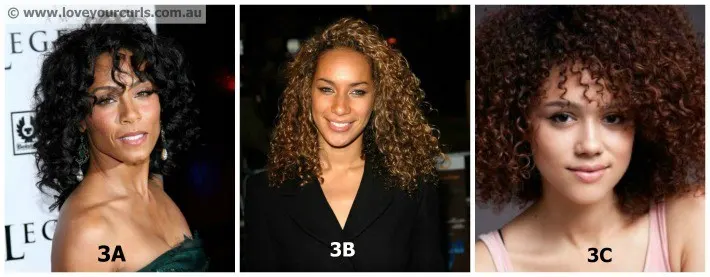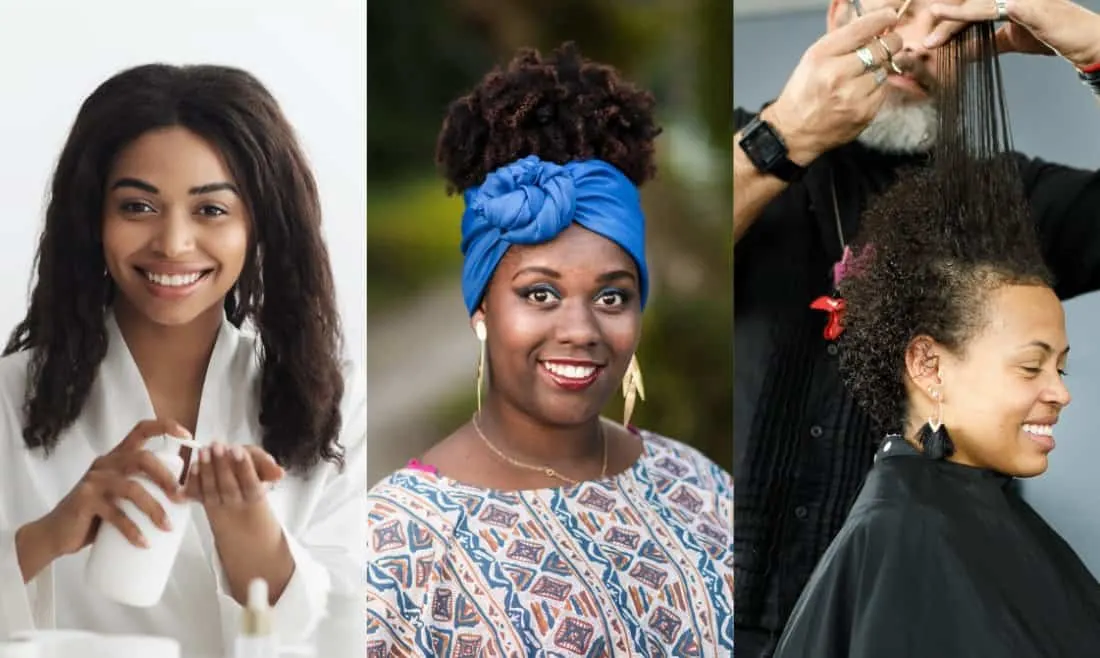If you’re new to natural black hair community, you may have heard a little bit about different black hair types. This pretty much gives you an idea of which category your hair type(s) falls under so that you can get a better idea of which products and methods work best for your hair. There are 4 different hair types, but the main ones discussed within the natural black hair community are type 3 and type 4 hair, which is predominant within the black community.
Black Hair Types
As discussed earlier, black hair types generally refer to 2 types: Type 3 & Type 4 hair. So, let’s discuss these 2 black hair types so that it gets easy for you to understand which type your hair falls into. Knowing your hair type will help you to take care of it the best way.
Type 3

The Type 3 hair is typically soft in nature, but still requires a lot of moisture, maintenance and care. Usually, this hair type is best styled in a wash & go, but the versatility of styles you can achieve is virtually endless.
Type 3 hair tends to frizz up easily, so look for a gel, sebum or edge control product that will keep the frizz and flyaways to a minimum.
You will also want to stay away from very heavy products since they have the tendency to weigh down your curls, leaving them with a limp, greasy appearance. Although 3C hair types can typically handle heavier products, if you’re closer to a 3A sticking to lightweight moisturizers and oils would be your best bet.
Type 4

Type 4 is the curliest of them all, featuring tight curls, coils and kinks. This texture is also one of the most versatile since shrinkage gives the illusion of shorter hair even if the hair is waist-length.
People tend to have a love-hate relationship with Type 4 hair, but its maintenance isn’t difficult if you understand the nature of the hair and how it reacts to certain products and styling techniques. One major thing to keep in mind is that you have to be extra careful handling type 4 hair, as it is very prone to breakage and knotting. Type 4a tends to have very small, ringlet curls and coils and can have shrinkage of up to 70% of its actual length.
Type 4b pretty much behaves the same way that 4a does, but it tends to either have very tight coils or have a zig-zag pattern.
Type 4c is the most delicate of all, featuring no real curl pattern and boasting shrinkage of up to 85% of its actual length. This hair needs the most moisture and tends to react very well to the LOC (leave-in, oil, cream) or LCO method.
Black Hairstyles With Short Length Hair
How to Identify Your Black Hair Type

Type 3 and type 4 hair are the most commonly seen in the black hair community. Here, we will expand upon this definition to help determine if you have type 3 or 4 hair.
Curl Shape
As stated above, a simple way to distinguish between hair types is the shape of the curl pattern. “S” shaped curl patterns that are common with type 3 hair may be referred to as “ringlets” and will appear looser than the “Z” shaped curl pattern that is prevalent on those with type 4 hair.
Hair Density
Density is greater in hair type 4 than in hair type 3 due to the curls adding significant weight and body to the hair. This can create some beautiful styles that are not possible in type 1 and type 2 without a large number of products due to the lack of density.
Thickness
Similar to density, type 4 is a denser hair than type 3 due to the thickness added by curls.
Porosity
Type 3 and type 4 hair typically have increased porosity compared to the other hair types. This is good because it can hold onto the product and moisturizing agents you use in your hair care routine. While type 1 and 2 hair may lose volume or appear greasy with the addition of healthy oils and styling agents.
Problems of Black Hair Types
Hair types 3 and 4 are the driest. This means that moisturizing must be at the top of your list. You shouldn’t wash it too often and when you do, choose the right shampoo. Ideally, buy a sulfate-free shampoo because sulfates remove the natural oils present in your hair. After washing, it’s a good idea to use a high-quality moisturizer to prevent excessive dryness and make you look the best.
Another problem that occurs in these types of hair is frizz. To avoid that, don’t use a brush to untangle your hair. This will worsen the frizz and make your curls uneven. Don’t dry your hair with a hair dryer either, as it will also contribute to hair frizz.
Maintenance Tips

Shampooing– Be sure to use shampoos that are moisturizing and stay away from sulfates as they tend to dry out the hair and scalp. For any natural, co-washing or using a cleansing conditioner is the best option since the co-wash won’t strip the hair of moisture.
While washing the hair in sections is easier, it is not required and pretty much depends on the density and thickness of your hair (if your hair is thick you may want to wash and detangle it in sections).
A great tip to keep in mind while shampooing is to hold the hair tight while scrubbing the scalp-this will keep tangles at bay and allow the suds to run down the length of the hair more efficiently.
Conditioning: Deep conditioners are the best option when maintaining the health of any curly hair type. While regular conditioners offer a good amount of moisture, deep conditioners will both repair and moisturize the hair from the inside out, giving it what it needs to remain healthy and strong. Since our hair is typically dry in nature, deep conditioning should at least be done once a week in order to maintain a proper balance of moisture.
Moisturizing: After washing and conditioning the hair, the hair still needs to be moisturized again before styling. Moisturization will keep the hair supple and manageable during the styling process so that the amount of breakage experienced is reduced. It is important to moisturize multiple times per week, so be sure to choose a moisturizer that will not leave the hair greasy or weighed down.
Styling: Using a gel or curl enhancing product will bring out the natural curliness of the hair. Be sure to not use products that contain alcohol, since alcohols will dry out your hair and leave it looking dull. To get the best results, apply the product in small sections making it through with your fingers. Once the product is applied throughout the whole entire head, follow up with light oil or serum in order to deter frizz and lock in the moisture.
Drying: With curly hair, it is always best to air dry, but you can also use a diffuser or blow dryer. If you do choose to blow the hair out, use the tension method with a nozzle attachment at a medium heat setting. If you opt to air dry but still want a stretched result, try braiding, twisting or banding the hair in order to stretch it out as it dries. Not only will this prevent the hair from knotting and tangling, but it will also leave you with a cute style once you take the hair down.
Heat Styling: Always apply a heat protectant before using any heated styling tool. If you’re straightening the hair, you may want to use a serum or heat protectant that is anti-frizz and anti-humidity so that the hair does not revert back as quickly.
Tight hairstyle: Tight hairstyles such as dreads or braids, or even tight ponytails, can add personality while making your hair easier to manage. But these styles require maintentance, too. When tying your hair, try a silk or satin headband or bandana instead of an elastic hair band. Covering your hair is also a good way to keep it away from sweat.
Hair trimming: If you want to trim your own hair at home, it’s easy to do with a bit of patience. First, ensure that you have shear scissors (scissors specifically made to cut hair). Other kinds of scissors may damage your hair, as their blades are not sharp enough. Then, comb your hair to detangle it; you can do this when your hair is dry or slightly damp. Finally, divide it in sections and twist it or braid it so that it’s easier to see if there are split ends. Trim the ends with diagonal cuts – this method keeps the hair healthy.
